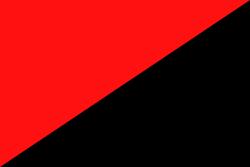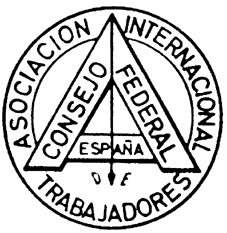Still working to recover. Please don't edit quite yet.
Anarchist symbolism
| |
Echo of Freedom, Radical Podcast has a podcast related to this aticle Anarchist Symbolism |
EoF |
The anarchy symbol, as it is popularly known, represents the ideals of anarchism. In recent years, however, the symbol has become associated less with anarchism in general and more with the anarcho-punk movement.
It should be noted that this particular symbol is certainly not the only one used by anarchists. In fact, the ideals espoused by the various anarchist movements preclude the use of a single symbol. There are many other symbols of anarchism, most notably the black flag.
Contents
[hide]Circle-A[edit]
Description[edit]
The Circle-A is almost certainly the best-known present-day symbol for anarchy. It is a monogram that consists of the capital letter "A" surrounded by the capital letter "O". The letter "A" is derived from the first letter of "anarchy" or "anarchism" in most European languages and is the same in both Latin and Cyrillic scripts. The "O" stands for order. Together they stand for "Anarchy is Order" the first part of a Proudhon quote.[1]
This character can be written as Unicode codepoint U+24B6. In addition, the "@" sign or "(A)" can be used to quickly represent the circle-A on a computer.
Pre-Anarchist usage[edit]
An early occasion when the encircled A was used was in Stephan Michelspacher book Spiegel der Kunst und Natur (The Mirror of Art and Nature) which was published in Augsburg 1615. This was an Alchemical work strongly influenced by Agrippa's view of the Kabbalah and magic. Adam McLean describes the centre panel as "two circular diagrams with the German GOTT (the name of God) around the outside, and also the Alpha and Omega @ and the monograph which may be the name of God, Agla.[1] This represents the beginning - alpha - within the end - omega (the first and last letters of the Greek alphabet. This relates to the claim related in the Book of Revelation that Jesus was "the "Alpha and Omega, the beginning and the end, the first and the last" (22.13). Many Anarchists have been Freemasons, and rosicrucian imagery of this type was used by the Golden Dawn. The Anarchist (and police spy) Theodor Reuss was associated with William Wynn Westcott, one of the founders of the Golden Dawn, before setting up the Ordo Templi Orientis. Two offshoots of this - Ancient Mystical Order Rosae Crucis and Aleister Crowley's Thelema used the formulation "Do what thou wilt shall be the whole of the Law", which many have taken up as an anarchist slogan.
History of Anarchist usage[edit]
The first recorded use of the A in a circle by anarchists was by the Federal Council of Spain of the International Workingmen's Association. This was set up by the freemason[2], Giuseppe Fanelli in 1868. It predates its adoption by anarchists as it was used as a symbol by freemasons amongst others.
It was later used in the Spanish Civil War,(1936–1939). There is a picture of an anarchist militia member with the circle-A painted clearly on the back of his helmet. It was adopted as a symbol of the Alliance Ouvrière Anarchiste (AOA) as its symbol at its 25 November 1956 founding in Brussels, and appears to have been independently reinvented in 1964 by the French group, Jeunesse Libertaire ("Libertarian Youth"). [3]
Anarcho-punk modifications[edit]
Frequently, the artist drawing the symbol will add a number of embellishments in order to further symbolize the ideals of anarchism. Almost always, the symbol is drawn by hand without the aid of straightedges, so as not to be overly neat. As anarchism is a rejection of the pre-existing order, the anarchy symbol thus distances itself from other symbols that are traditionally drawn neatly (e.g., currency symbols).
The "A" is frequently rendered with its horizontal line extending beyond the two diagonals, and often skewed off of the horizontal. The letter is typically scaled so that the majority of the five points of the "A" lie outside the circle, although the center of the letter remains inside. Namely, the five points are (1) the intersection of the two diagonals; (2) and (3) the other ends of the two diagonals; (4) and (5) the ends of the horizonal line.
The result of this particular typical embellishment, intentionally or not, is a similarity to the pentagram, which some Christians frequently associated with satanism. Ironically, both the pentagram and the anarchy symbol are primarily used to symbolize ideas and ideals that have nothing to do with satanism. Despite this fact, the pentagram and (to a lesser degree) the anarchy symbol are associated with satanism by many Westerners.
Occasionally, the symbol will be made to look like it was drawn in flame or blood splatters. Even if this embellishment is not used, red on a black background is a popular color choice since these colors have been associated with the anarchist movement for over a century (see anarcho-syndicalism and compare with the anarcho-syndicalist red-and-black flag).
These last few design choices may be due to the possibly unfounded association of anarchy with satanism — many who draw the anarchy symbol are using it simply as a symbol of rebellion against authority. The Western world has historically been under the authority of Christianity. It is natural, therefore, for rebellious youth to seek out what they view as the antithesis of authority, which in Christianity's case is Satanism. Lucifer's Fall from grace depicts images of rebellion against the authority of God, a stance demonstrating a parallel between Satanism and anarchism.
The anarcho-punk movement embraces the heavily stylized circle-A. More traditional, political anarchists do not add so many embellishments, or they don't use this symbol at all. Some anarchists feel that the symbol has been commercialized by a few artists wishing to sell albums, caring little for the benefits of anarchy as a system of non-government. While it can't be taken as absolute fact, some anarcho-punks note that more punks and punk bands that actually are anarchists use the traditional circle-A, rather than the stylized one, which is used much more often by those who do not have much knowledge of anarchism.
As a result of its draw as a symbol of rebellion and of the anarcho-punk movement, the anarchy symbol is frequently seen drawn or spray-painted on walls as graffiti.
Black flag[edit]
Description[edit]

The color black has been associated with anarchy since the 1880s. Many anarchist groups contain the word "black" in their names. There have been a number of anarchist periodicals titled Black Flag.
The uniform blackness of this flag is a representative of the negation of all oppressive structures. A plain black flag is almost an anti-flag (colourful flags being the usual symbols for nation states). Additionally, a white flag is the universal symbol for surrender to superior force — thus a black flag can be viewed as the polar opposite of surrender. Others have suggested that the black flag symbolises mourning for those martyred in the course of the struggle.
The black flag is also carried by Shiah Muslims.
History[edit]
Many anarchist theories are adopted and modified versions of the central tenets of socialism, whose symbol is a red flag. As anarchism began to distinguish itself from socialism in the 1880s, it simultaneously adopted the black flag as its symbol to differentiate it from other socialist currents. However, anarchism is not a direct descendant of socialism. Anarchism did not spring from any one source.
Many anarchists have said that the black flag represents the absence of a flag, that is, it represents no nation-states or other authorities. The black flag stands in opposition to all authority, nation-states, and hierarchical institutions. On this note, one could also go far enough to say that it rejects the myth of representation, rejecting the idea that anyone (Or for this matter, anything) can represent a group of people.
Regardless of the exact origins of anarchism, it is a fact that the color black became associated with anarchism starting in the 1880s, as a sign of mourning for the Paris Commune. The French anarchist paper, Le Drapeau Noir ("The Black Flag"), which existed until 1882, is one of the first published references to use black as an anarchist color. Black International was the name of a London anarchist group founded in July 1881.
In the Russian Revolution of 1917, Nestor Makhno's anarchist forces were known collectively as the Black Army. They fought under a black flag with some success until they were crushed by the Red Army (see Black Guards). Emiliano Zapata, a Mexican revolutionary in the 1910s, used a black flag with a skull and crossbones and the Blessed Virgin Mary on it. The flag's slogan was "Tierra y Libertad" ("Land and Liberty"). In 1925, Japanese anarchists formed the Black Youth League, which had branches in the then-colonial Taiwan. In 1945, the group named their journal Kurohata ("Black Flag").
More recently, Parisian students carried black (and red) flags during the massive General Strike of May 1968. In the same year, these flags were seen at the American Students for a Democratic Society national convention. Also at about the same time, the British based journal Black Flag was started, and is still in existence today. Black flags remain a symbol of anarchists today.
The color black is as much associated with Fascism as it is with Anarchy. Benito Mussolini gained power in Rome with the help of his Blackshirts, who sometimes carried black flags, through they were usually adorned with a white fasces, the symbol of Ancient Rome. The Fascists chose black essentially because it was the opposite of red, the color of socialism, which they wanted above all else to distance themselves from. Some of the fascists had previously been involved in the anarchist movenment, and indeed Proudhon was often held up as a precursor of their ideology, particularly those influenced by Georges Sorel and Henri Bergson.
Other anarchist symbols[edit]
The circle-A and the black flag are the primary symbols applicable to anarchism as a whole. However, various anarchist groups throughout history have developed their own symbols.
Red and black flag[edit]

The red-and-black flag is the symbol of the anarcho-syndicalism and anarchist communism movement. Anarcho-syndicalism, which is part of the labor union movement, draws its principles from both anarchism and more heavily from socialism than many other anti-capitalist anarchist movements. As discussed in the black flag section, black is the traditional color of anarchism, and red is the traditional color of socialism.
The red-and-black flag combines the two colors in equal parts, with a simple diagonal split. Typically, the red section is placed on the top-left corner, with the black on the bottom-right corner of the flag. This symbolizes the co-existence of anarchist and socialist ideals within the anarcho-syndicalism movement, and to symbolize the more socialistic means of the movement leading to a more anarchistic end.
A notable anarcho-syndicalist group is Spain's Confederación Nacional del Trabajo (CNT), which still exists today. The CNT, along with the Federación Anarquista Ibérica (FAI), a major militant faction within the CNT, was a major player in the popular anarchism movements in Spain of the late 19th and early 20th centuries.
This group has its own version of the red-and-black flag with its initials on the flag. CNT is in the red, while FAI is in the black — the color of anarchy — as the FAI was founded in 1927 to keep the CNT dedicated to anarchist principles.
This design influenced the flag of Spanish Falange, a right-wing, National syndicalist group that wanted to transcend the class struggle by corporatist vertical trade-unions, and with was eventually absorbed into the FET y de las JONS of Francisco Franco.
Black and Gold Flag[edit]
The black-and-yellow or black-and-gold flag is used by "anarcho"-capitalists and other right-wingers seeking to co-opt leftist aesthetics and symbology, "market capitalists". The yellow is intended to symbolise gold, a commodity of exchange potentially used in marketplaces unrestricted by state intervention, and inevitably devoid of the egalitarianism and other ethics characteristic of the other types of anarchism. The upwards slant between the gold and black halves represents a sure and steady upward growth trend that would supposedly occur under a market "anarchy". Or alternatively it could symbolize a backwards slide down from the peak of wealth that capitalists who at least knew enough about economics to accumulate gold for themselves reached before the oil ran out. The flag was first used in public in Colorado in 1963 at an event organised by Robert LeFevre.[15]
Black cat[edit]
The black cat, also called the "wild cat" usually with an arched back and with claws and teeth bared, is closely associated with anarchism, especially with anarcho-syndicalism. It was designed by Ralph Chaplin, who was a prominent figure in the Industrial Workers of the World (IWW). As its stance suggests, the cat is meant to suggest wildcat strikes and radical unionism. The IWW (or the Wobblies) was an important industrial union, and was the first American labor union to recruit and organize women and people of color, and played a critical role in the fight for the 8 hour work day and in Free Speech fights all over the country in the early 20th century. Their most famous and influential years were from 1905 until they were largely suppressed by the Palmer Raids. Contrary to some historians' accounts, the IWW never died and remains an active labor union today. In the 1990's the IWW experienced a major revival, and is now one of the fastest growing labor unions in America, and the nations largest explicitly anti-capitalist organization. Current campaigns are focussed mostly on low-wage service industry workers, and in 2005 the IWW became the first American labor union to successfully unionize a Starbucks coffee shop (in New York City). They embrace the black cat as a symbol of the worker's movement.
The origin of the black cat symbol is unclear, but according to one story it came from a IWW strike that was going badly. Several members had been beaten up and were put in a hospital. At that time a skinny, black cat walked into the striker's camp. The cat was fed by the striking workers and as the cat regained its health the strike took a turn for the better. Eventually the striking workers got some of their demands and they adopted the cat as their mascot.[4]
The name Black Cat has been used for numerous anarchist-affiliated collectives and cooperatives, including a well-known music venue in Austin, Texas (which was closed following a July 6, 2002 fire) and a now-defunct "collective kitchen" in the University District of Seattle, Washington.
As a symbol, the black cat has historically been associated with witchcraft, ill omens, and death. It dates back to ancient Hebrew and Babylonian cultures. The witchcraft usage has persisted into modern times; anarchism shares the black cat symbol with witchcraft and Wicca, though the latter two generally do not represent the cat with its back arched in a fighting stance.
Black Cross[edit]
The Anarchist Black Cross organization's primary goal is to eliminate all prisons. It originated in Tsarist Russia as a support organization for political prisoners. Their symbol is a black cross, with the upwards-facing line being replaced with a 'clenched fist' 'closed fist', or 'raised fist', a symbol also associated with anarchism, defiance of authority, and personal empowerment (black power, youth power, women's liberation, American Indian Movement, International Socialist Organization, 'power to the people', etc...). The fist also represents union, as "many weak fingers can come together to create a strong fist".
The cross is a modification of the Red Cross emblem used by International Red Cross and Red Crescent Movement (founded 1863), the world's largest group of humanitarian organizations. Originally called the Anarchist Red Cross, the name was changed around 1920 to avoid confusion when the Red Cross started organizing relief for prisoners as well. Like the Red Cross, this symbol is not intended to be overtly Christian, though it may be ultimately derived from the Christian cross. The Red Cross and Anarchist Black Cross are humanitarian symbols; the Christian cross is a religious symbol.
Wooden shoe[edit]
The wooden shoe was used symbolically by anarchists in the 19th and early 20th century, although it has largely faded from use since then. The French word for wooden shoe, sabot is the probable root of the word sabotage: and refers to the tactic by early Dutch unionists of throwing wooden shoes into the gears of factory or farm machinery, effectively stopping work until the equipment could be repaired. The American analogue of this tactic is "monkeywrenching," referring to the similar practice of throwing a monkeywrench in the machinery to damage it and prevent scabs from being able to replace workers on strike.
In Philadelphia, Pennsylvania, there is an anarchist bookshop called The Wooden Shoe, and from 2001 to 2003 there was an anarchist magazine in Denmark called Sabot.
Black and purple flag[edit]
A simple variation of the red and black Anarchist flag, the black and purple is used in association with Anarcha-Feminism. Much like the pink and black flag (below) it focuses on the "struggle against sexism and patriarchy".
Black and green flag[edit]
The black and green flag is a modification to the original black and red flag of anarchism. This flag is used by social ecologists, eco-anarchists, anti-civilization anarchists and primitivists. It is generally taken to symbolize a vision of anarchism that focuses on the self-determination of all forms of life (animals, humans, bioregions) and not just humans. Hence the green.
Black and pink flag[edit]
Another variation of the black and red flag, the black and pink flag is used by queer anarchists, and sometimes by Anarcha-Feminists. Unlike the black and green flag, it doesn't necessarily represent another form of anarchism, but is used to focus on (opposition to) the hierarchial patterns of heterosexism, sexism, transphobia, and patriarchy.
Stars[edit]
Variations of the anarchist flags (above), only in the shape of a five-pointed star.
Variations of the star exist as adaptations of the flags, there are black and red, green, pink, purple and others.
Black Rose[edit]
The Black Rose is a little known symbol of the anarchist movement. The political origins of the Black Rose can be traced to the Irish song about their struggle against the British, “Little Black Roseâ€. The song is one of resistance and rebellion, and as such aligns to the general view adopted by anarchists of anti-authoritarianism.
Jolly Roger/Pirate flag[edit]
The Jolly Roger as a black flag with skull and bones has recently gained a popularity among anarchists.
Some claim to use the Jolly Roger as a form of appreciation for the Pirate way of life in freedom and a lack of authority. Many Pirate ships were loosely democratic and most crew mates were working class fugitives from the highly repressive societies in which they were born. Hakim Bey referred to stateless pirate societies as pirate utopias.
"Eat the Rich"[edit]
A variation of the Jolly Roger, but with a longer history among anarchists, the "Eat the Rich" symbol has been around since at least the 1980s. At first sight it looks like the Jolly Roger, but the crossed bones are replaced by a knife and a fork. It is mostly an anarcho-punk symbol.
The "Eat the Rich" slogan was popularized within the anarcho-punk community by Motorhead's 1987 song by that name, and more broadly by the 1993 Aerosmith song of the same name, found on the "Get a Grip" album. A red t-shirt bearing the "Eat the Rich" symbol was distributed as a promotion for the album.
African Anarchism[edit]
This symbol is used mostly by the Zabalaza Anarchist Communist Front (ZACF). The ZACF (formerly known as the Zabalaza Anarchist Communist Federation or ZabFed) is a federation of platformist-especifista anarchists in South Africa. ZACF members share a basic agreement in terms of theoretical and tactical unity, collective responsibility, and federalism as per their not-uncritical acceptance of the "Platform". In historical terms the platformist tradition starts with The Organizational Platform of the General Union of Anarchists (Draft), a draft discussion document by the Dielo Truda group of Russian anarchist exiles, and includes the Friends of Durruti grouping of CNT members during The Spanish Revolution who wrote Towards A Fresh Revolution. In the post-war period many include documents like the Georges Fontenis' pamphlet Manifesto of Libertarian Communism.
The symbolism of a united Africa, displayed in traditional anarcho-communist colours, is an important one, as a mixture of different demographic groups are represented by Zalabaza in the midst of a societal environment that is otherwise tense with post-colonial racial and sexual issues.
See also[edit]
References[edit]
- ^ 'Alchemical Mandala No. 6' by Adam McLean, in The Hermetic Journal No. 6, London, 1979
- ^ 'La MasonerÃa y el movimento obrero' by Alberto ValÃn Fernández.
External links[edit]
- Text-only version of the above
- Anarchism at the Flags Of The World website
- Wooden Shoe Books
- Anarchism and the History of the Black Flag
| This article contains content from Wikipedia. Current versions of the GNU FDL article en:Anarchist symbolism on WP may contain information useful to the improvement of this article | WP |









